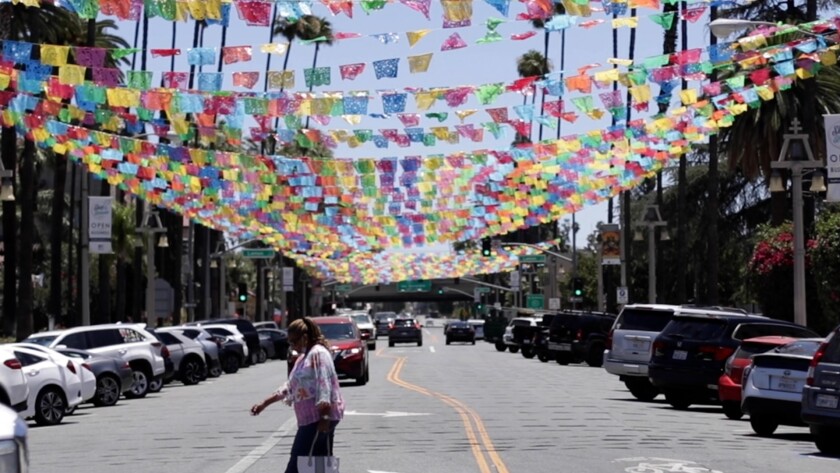MORENO VALLEY, Calif. —
My ideas about the Inland Empire have always been seeded with a prickly skepticism.
As far as I was concerned, passing through towns like Rialto, Colton and Jurupa Valley along Interstate 10 and State Route 60 was a necessary inconvenience on the way to the desert — not a chance to learn something about life in America.
But I was intrigued by the most recent U.S. census figures showing the Inland Empire to be one of the fastest-growing regions in the country and that waves of Black and brown transplants, many from Los Angeles and Southern California’s other urban centers, have driven a cultural transformation that’s been decades in the making.
The population has swelled to 4.6 million people spread across Riverside and San Bernardino counties — and an area that was once known for its whiteness is now about 70% people of color.
The presence of Black and brown faces isn’t new, but when I set out to understand why so many are packing up and moving to the Inland Empire now, I learned that it wasn’t simply because the region is regarded as a bastion of affordable housing in pricey Southern California.
MY COUNTRY
As a Black man in America, I’ve always struggled to embrace a country that promotes the ideals of justice and equality but never fully owns up to its dark history of bigotry, inequality and injustice.
Now, more than any time in recent history, the nation seems divided over this enduring contradiction as we confront the distance between aspiration and reality. Join me as I explore the things that bind us, make sense of the things that tear us apart and search for signs of healing. This is part of an ongoing series we’re calling “My Country.”
— Tyrone Beason
There was something else — a yearning that you can’t easily measure in numbers.
Again and again, residents expressed a burning need for a metaphorical timeout from the relentless pressure and pace of life in Southern California — even if that meant putting down roots in cities and towns between the ocean and the desert that many would be hard-pressed to pinpoint on a map.
I feel like America’s lurching toward a breaking point. Violent crime and racist attacks have been on the rise across the U.S. in the last few years, and mass shootings with at least four victims killed or wounded are a grim daily occurrence — this year there were 360 as of July 23, according to the Gun Violence Archive, an online tracker.
In an unsettled nation riven by political divisions and culture wars, many Americans have seemingly lost their ability to let down their guard and connect with one another.
But out here among the bone-dry arroyos and housing developments with gently winding lanes, the “craziness” of metro L.A. seems a world away, one young Black couple say as they push a baby stroller down a street lined with banners advertising new homes in Beaumont — 80 miles east of the big city.
To escape the daily grind that comes with living in the big city, people of color are finding peace in the Inland Empire in the search for their American dream.
Another newcomer, Manuel Gutierrez, looks carefree as he grills spicy whole chickens at his roadside Mexican street food stand surrounded by horse ranches in Moreno Valley, near Riverside.
Gutierrez, 33, offers up a single word to explain why, besides cheap land, it made sense to leave the community where he grew up in South-Central L.A. and start over in the Inland Empire.
“Peace.”
The late Sacramento-born writer Joan Didion once described the Inland Empire as “a harsher California” plagued by nerve-racking Santa Ana winds, deadly wildfires, a boom-and-bust economy and a menacing emptiness in some stretches.
What little I understood about the area came from news clippings about white supremacist rallies, and stories about the heyday of Route 66, when badlands were covered in chaparral and Black people risked being attacked in sundown towns simply for getting caught within city limits after dark.
I drive north along two-lane roads that wind between the city of Moreno Valley and the San Bernardino Valley and am transported to a bygone Golden State. Blossom-scented orange groves have been planted so close to the asphalt that someone in the passenger seat could pick the fruit from the car.
Every mile or so, signs warn of wild burros, and every so often, I spot herds of the big-eared animals grazing by the road, alarmingly close to speeding traffic.
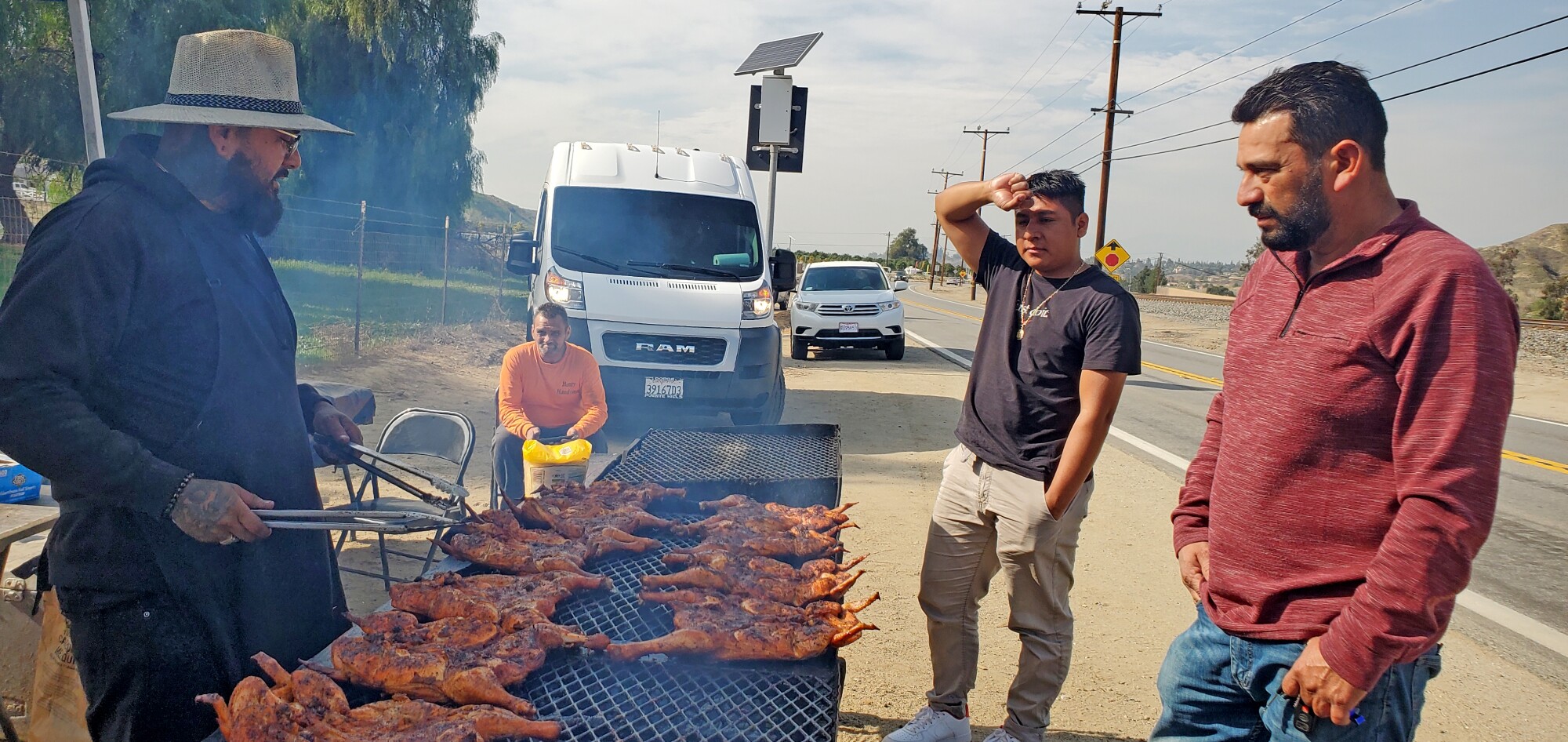
Manuel Gutierrez, left, formerly of South-Central L.A., moved to the Inland Empire partly for its peaceful atmosphere.
(Tyrone Beason / Los Angeles Times)
It’s a disorienting scene, but the Old West vibe isn’t the only thing that endures.
Democrats may have made historic gains in this region thanks to demographic trends, but as I move from city to city I lose track of the number of “Let’s go Brandon” flags I see flying in front of homes and from the back of pickup trucks, an esoteric dig at the Democrat who won the 2020 election. I’m taken aback by a banner in the front yard of one house that makes the owner’s disdain toward President Biden hard to misinterpret: “Trump is my president.”
And yet, despite signs this might not be a welcoming environment, people of color are drawn here. The American dream can manifest in surprising places.
Fatima and Arthur Nelson II had their own reservations before they moved with their three children in early 2021 from Long Beach to Moreno Valley, a city of about 215,000 where residents ride horses on the streets and hillside trails.
But their new city’s racial diversity — which was missing in their old neighborhood — shocked them.
“It felt like a homecoming in a way,” says Fatima, 47, a community engagement specialist at UC Riverside’s Center for Social Innovation. “All of a sudden, we entered this Black community where there were all of these Black homeowners, which is a bit of a unicorn in Long Beach. I see a lot more shades and colors out here.”
The family’s ranch-style home — in a diverse middle-class neighborhood of older single-family houses — has high ceilings and a big backyard. The house may not be fancy, Fatima says, but it’s got “excellent bones” and was within the family’s budget.
Fatima has found something more elusive since moving in — an unexpected solitude.
“When I go home, it’s like it’s horns and sirens and the neighbors screaming next door,” Fatima says of Long Beach, where she grew up. “I almost feel guilty because I feel like we have fared so well.”
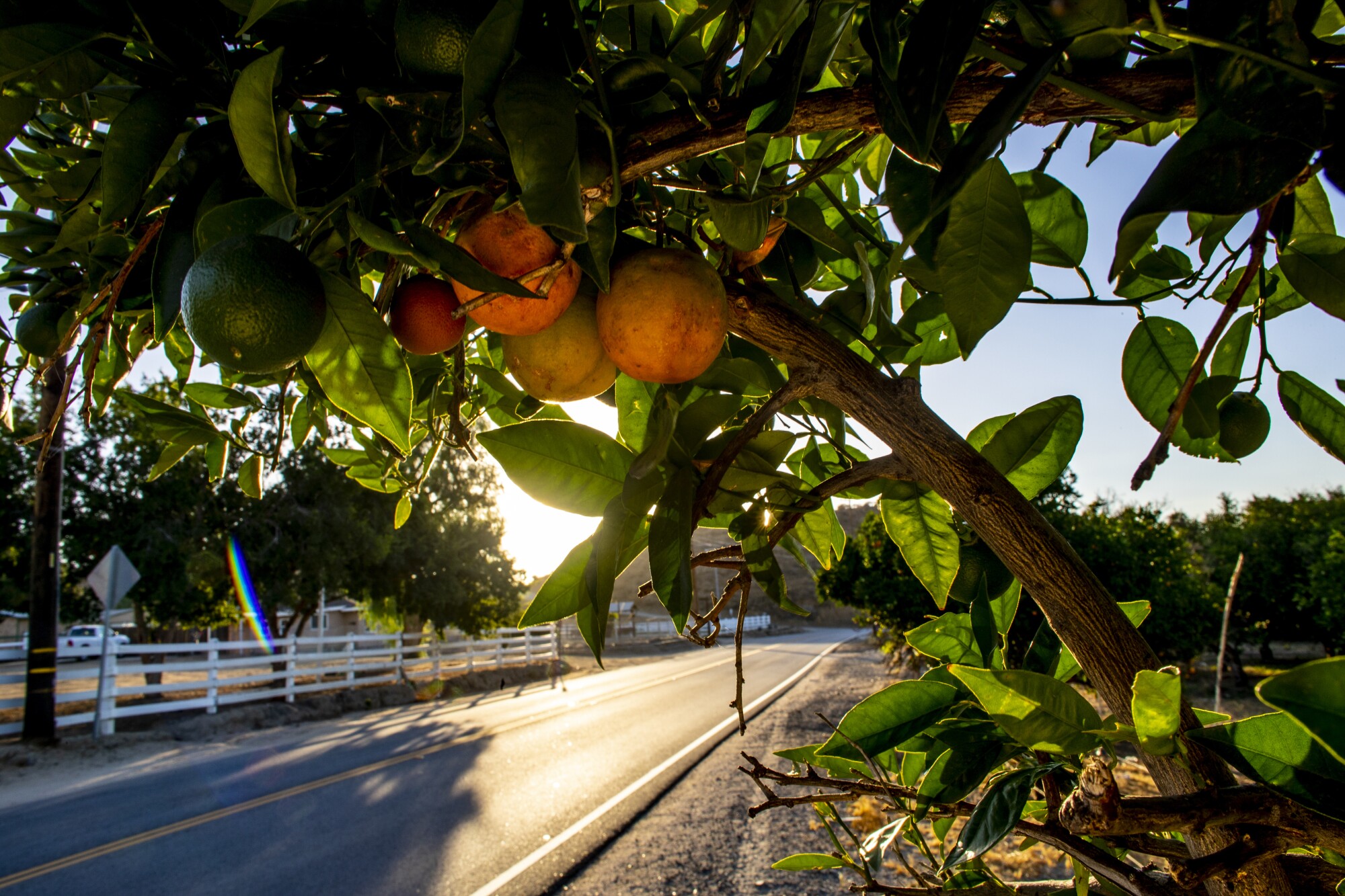
Orange groves thrive next to asphalt outside Moreno Valley. People are increasingly drawn to the area, and not only for more-affordable housing.
(Gina Ferazzi / Los Angeles Times)
Arthur, a manager at a logistics company, couldn’t see at first how his family would adapt to life in the Inland Empire. They had only lived in crowded urban areas — his hometown of Philadelphia, Jersey City, N.J., and Long Beach. The last year and a half had been a revelation.
“Sometimes in urban settings, with everything that city dwelling involves — sometimes you think that that is an omnipresent reality,” says Arthur, 46.
By contrast, he says that in Moreno Valley he’s experienced that other side of life he knew was there “but never enjoyed.”
“I know that’s what’s contributed to us being at peace in these troubled times,” Fatima says of their new community.
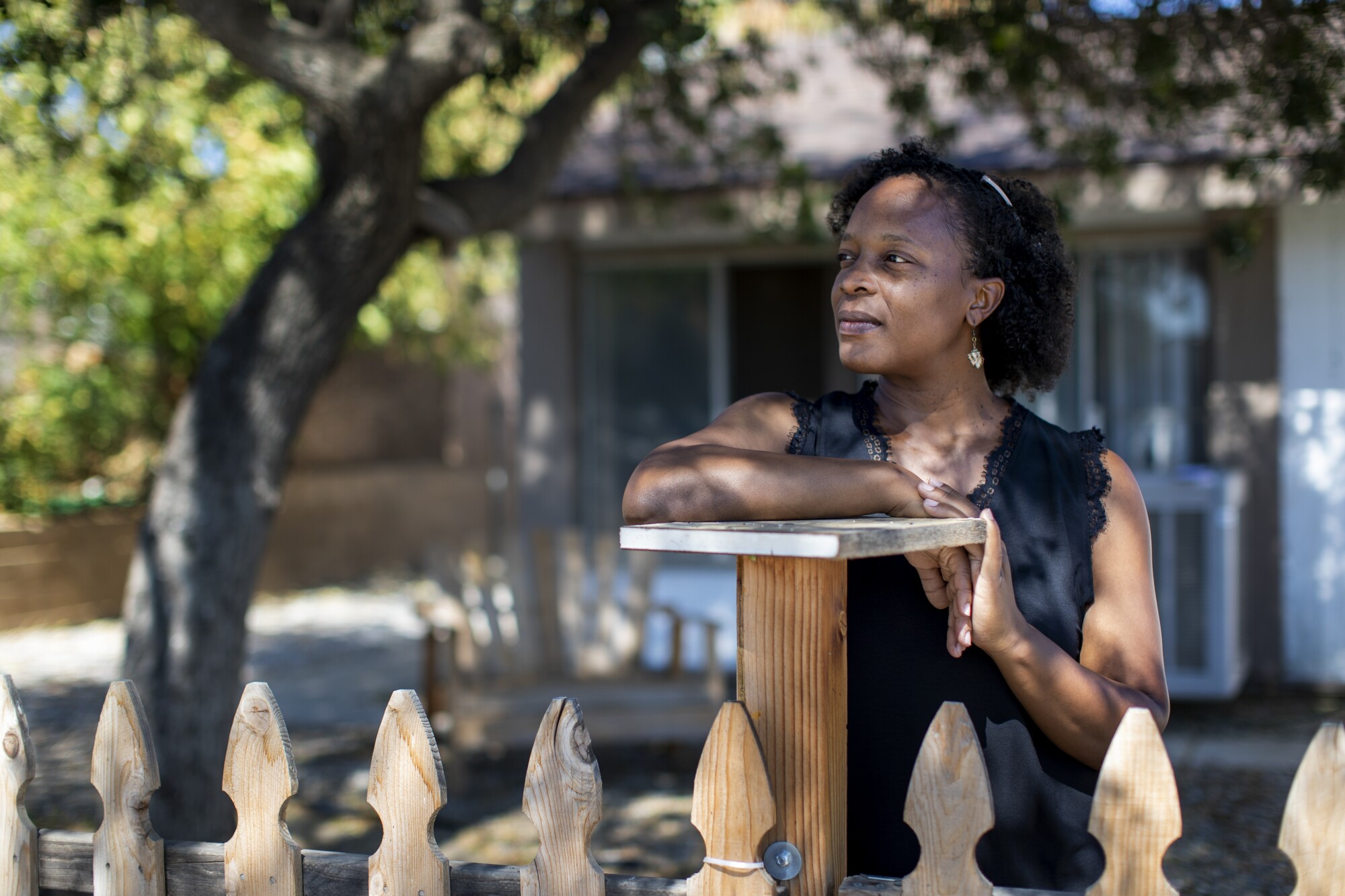
“It felt like a homecoming in a way,” Fatima Nelson says of her family’s move from Long Beach to Moreno Valley, where she sees “a lot more shades and colors.”
(Gina Ferazzi / Los Angeles Times)
During one of my visits, their son Arthur Nelson III sits next to Fatima on the couch as she explains how the move had benefited the couple’s three children: Tariq, 4; Arthur, 8, and Julia,15.
In Long Beach, the two older children attended excellent schools but they were among the few students of color. The Nelsons saw Arthur and Julia struggling in class and having a hard time forming friendships amid the cultural isolation.
“My husband and I decided that we will traumatize them no more” by keeping them in schools where few looked like them, Fatima says.
Son Arthur now attends an elementary school where Black children make up a quarter of the student body.
Watching him come into his own during his youth football games with the Inland Empire Hornets, allowing her daughter to walk home from school alone, Fatima says, are just the sort of experiences she and her husband dreamed of when they decided to rebuild their lives here.
“On the one side you think that it’s super boring and there’s nothing to do and you just go crazy in a different way,” Arthur says. “But now, you just want peace … and quiet.”
“We’re hoping to do a lot of repairing in the I.E.,” Fatima adds. “All of us.”
The contentment that the Nelsons and others convey keeps tugging at me as I grapple with my skepticism about a region that comes across as so poorly planned — and so removed.
Its land mass is vast — more than 27,000 square miles, larger than West Virginia. You’d have to fly over it all the way to the Nevada and Arizona state lines to take in its scale and fully appreciate the way its block-long warehouses, residential subdivisions and wide-open spaces come together like pieces of a giant puzzle.
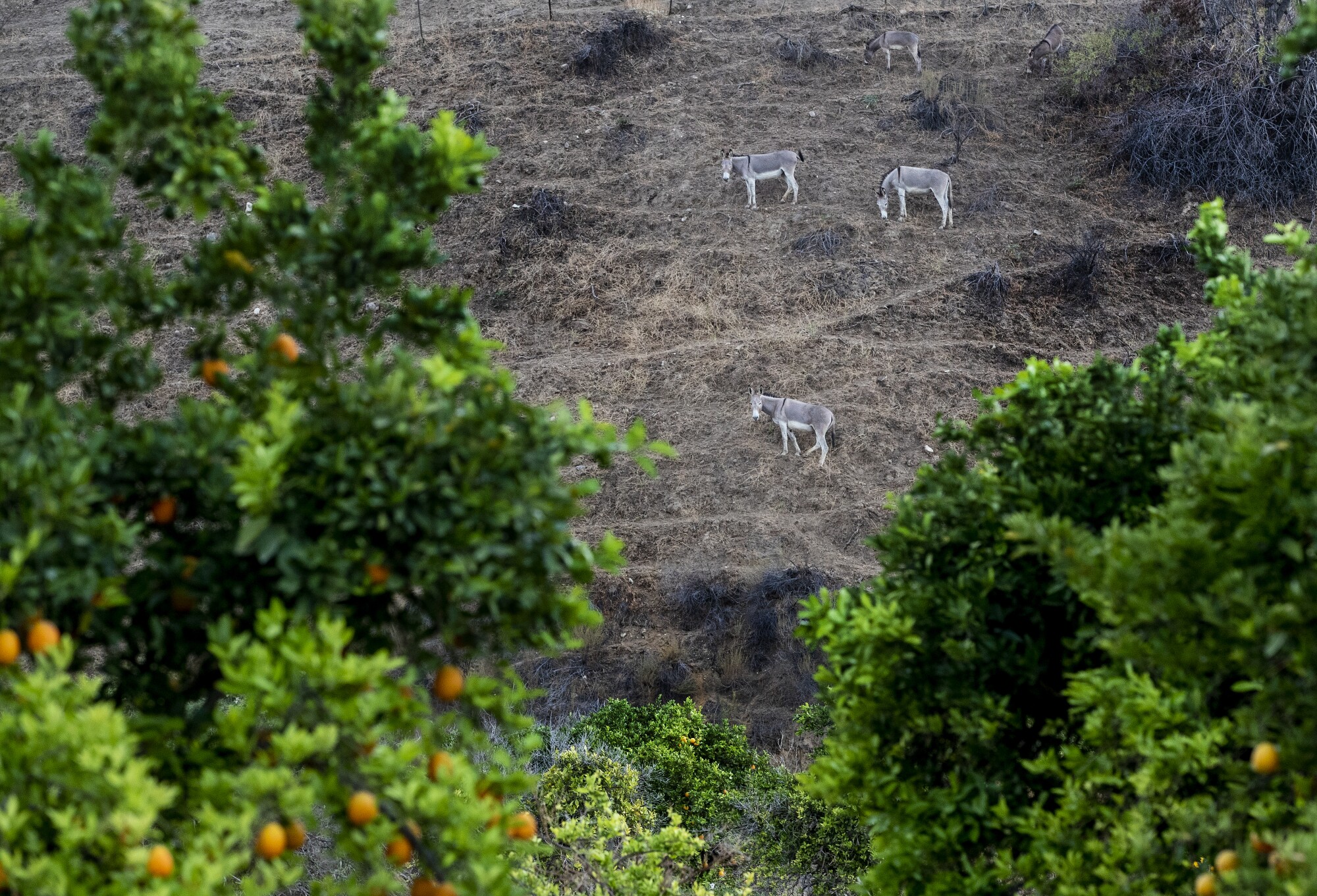
Signs along rural roads warn of the wild burros that sometimes graze alarmingly close to passing cars.
(Gina Ferazzi / Los Angeles Times)
Yet Black residents like Marcus Jones speak about life here as if under a spell.
I stop to talk to Jones as he hangs out in the parking lot of a community center in Rancho Cucamonga.
The 52-year-old food delivery driver, who lives a 45-minute drive over the San Gabriel Mountains in Hesperia, looks cool in a black hoodie and black shades while standing next to his black Mustang, whose name he’d stenciled in bold letters on the windshield — “Stella Black.”
“My true peace actually comes from the word of God, but then, of course, there’s this,” Jones says while gazing out at the leafy neighborhoods that climb toward the alpine ridges of Mt. Baldy in the distance.
“I come here, or I’ll go to another park, and lounge, look at the greenery, just take it all in,” he says.
“You’ve got those little white clouds up there — it’s breath-taking to me.”
When I ask him to explain what would make a Black man in a country as tense and torn as ours wax rhapsodic about palms and clouds, Jones grins as if to say, “Just look around, brother.”
Wilbert Branigan sounds just as entranced when he stops to speak in Rialto outside a ’50s-themed diner on Foothill Boulevard, where an exterior mural depicts the street’s history as part of the fabled Route 66 that ushered in earlier droves of newcomers.
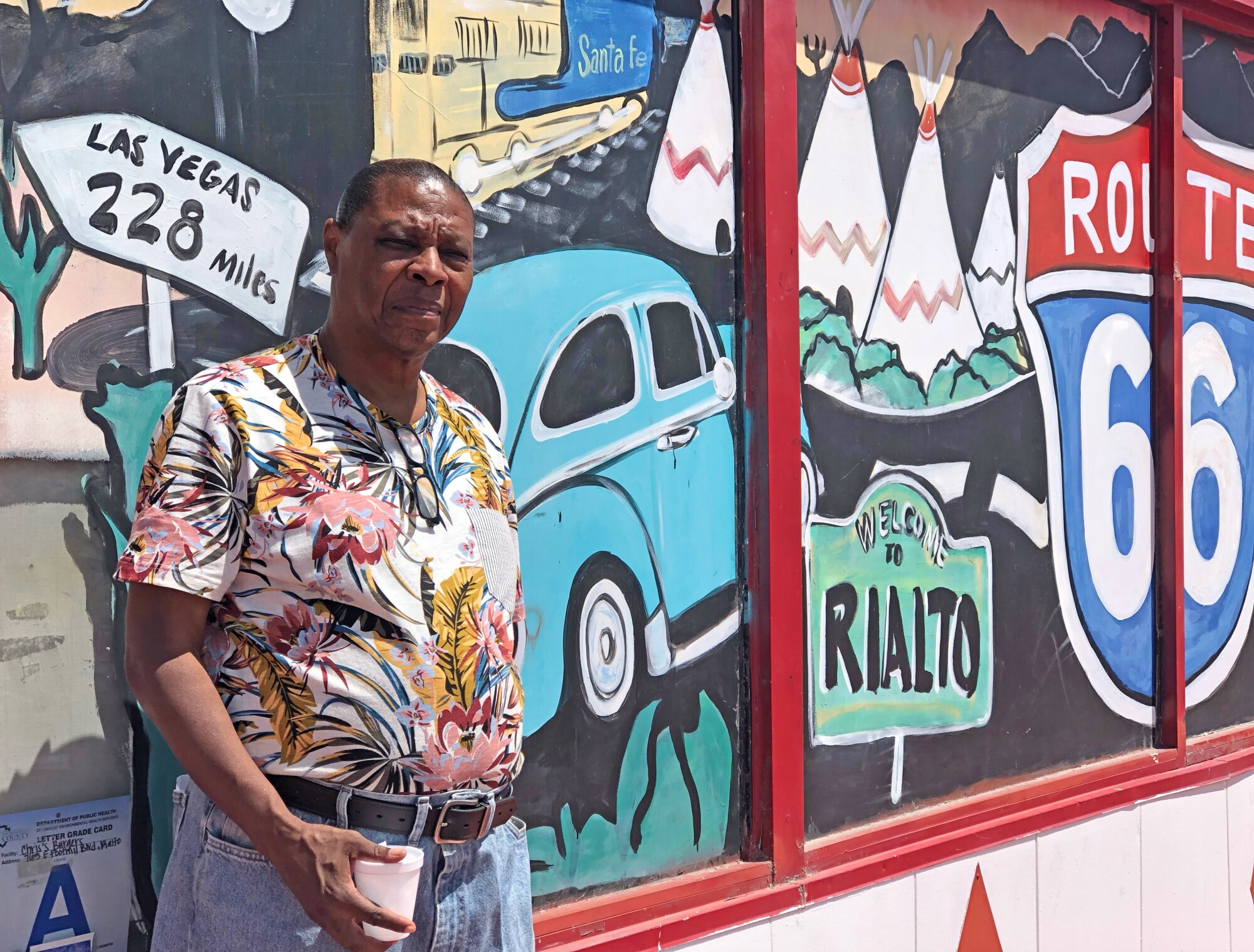
Wilbert Branigan, formerly of Las Vegas, says outside a Rialto diner that Black men can get along fine in the Inland Empire if they work hard and mind their business.
(Tyrone Beason / Los Angeles Times)
Branigan, who lives a short drive east near San Bernardino, says he’s certain that Black men in the Inland Empire like himself can still achieve an unbothered life if they work hard and mind their business.
Looking at ease in denim shorts and a T-shirt printed with tropical flowers, the long-haul truck driver, who’s 63 and originally from Las Vegas, leans in close as if to reveal a secret.
“There’s stress on the land right now, but can I say this honestly?” Branigan whispers, his immaculately slicked-back hair glistening in the sun. “There’s a God above, and he’ll fix all things. So I don’t worry.”
My charmed encounters with residents who love it here compete with the less glowing details I’m learning.
Black Californians in the early 20th century built leisure resorts for themselves in scenic corners like Lake Elsinore, south of Riverside; and Apple Valley, not far from Hesperia. It enrages me to think that racial segregation was so entrenched that enclaves like these felt like paradise by comparison.
In the rapidly expanding city of Beaumont, where I brush past families of different races on a tour of model homes boasting cavernous dens, upstairs TV lounges, mountain views and prices in the $500,000-to-$700,000 range, I can’t help but be reminded of what real estate broker April Schmidt and her colleagues shared with me.
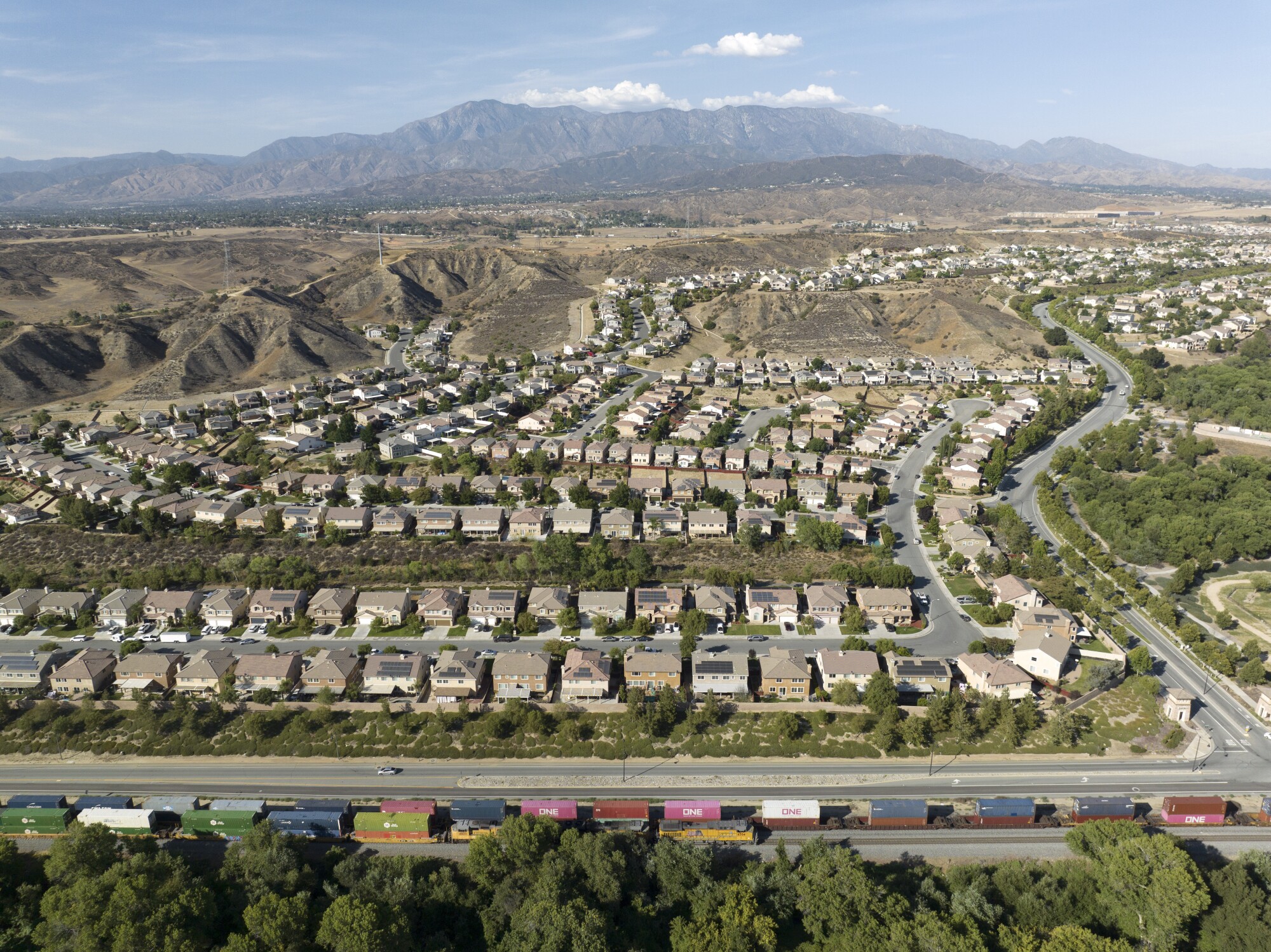
The growing Inland Empire city of Beaumont and neighboring Banning were once separated by a city street, with white people on one side and Mexican American and Black residents on the other.
(Myung J. Chun / Los Angeles Times)
A city street that divided Beaumont and neighboring Banning once separated where white people lived from Mexican American residents as well as Black transplants who’d been forced out of what is now downtown Palm Springs.
Fontana used to be so infamous for its tolerance of racism that when the current mayor, Acquanetta Warren, told her father in 1993 that she was leaving Compton and relocating her family to the inland city to escape the crime and racial tension of L.A., he questioned why she would “swap out gang-banging for Klan activity.”
And a sizable segment of the population can’t afford the many great things this region has to offer. I’ve driven past mobile home parks and homeless encampments deep in the desert, out of sight of the fancy resorts of the Coachella Valley.
In the business and transit hub of San Bernardino, nearly a quarter of the population of more than 222,000 lives in poverty.
Fatima’s work at the Center for Social Innovation includes sessions with residents of the Inland Empire to gather input that elected and business leaders can use to improve the quality of life.
The center’s research backs up what she and her colleagues have heard anecdotally: Only about 1 in 4 Inland Empire jobs pays enough for a family to cover its basic needs, and stress is taking a toll on some people’s mental health.
Activists have long complained that the spread of warehouses in one of the nation’s busiest distribution hubs has resulted in increased air pollution and rampant exploitation of workers.
“If you’re not sweating, you’re not working hard enough,” says Victor, 57, a Mexican American warehouse employee who’s been working in the industry for more than 25 years.
He’s afraid of retribution from his employer, so he declines to share his last name when we meet at the Warehouse Worker Resource Center, a nonprofit advocacy organization in Ontario.
He tells of having to use faulty equipment, toiling in buildings that lacked ventilation, going hours without a water break, being forced to take overtime shifts and working a second job cleaning offices at night so that he and his wife can provide for themselves and their 10-year-old daughter.
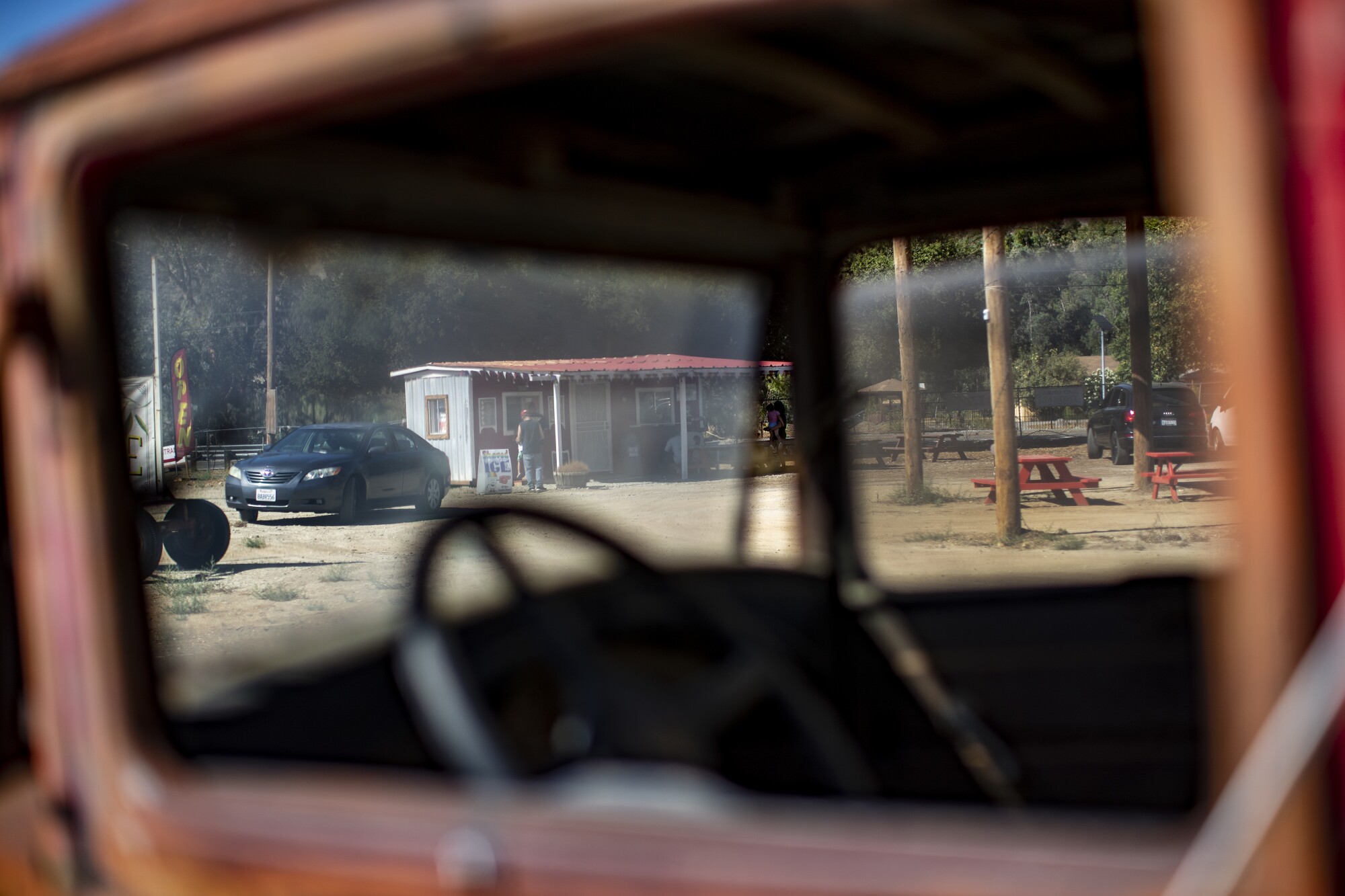
Customers buy lemonade and ice cream from a rustic store outside Moreno Valley.
(Gina Ferazzi / Los Angeles Times)
“Once they’re done with you,” he says in Spanish, his voice cracking, “on to the next.”
His eyes moisten with tears when I ask whether he’ll ever achieve the American dream living this way. Almost inaudibly, he says no.
Victor’s stories hit me like a punch to the gut. But when I relay what he told me to Warren, Fontana’s first Black mayor, she scoffs at claims of widespread worker abuse and environmental damage.
Although in April the city had to enact new air pollution rules for logistics centers after being sued by the state for approving a trucking warehouse next to a high school, Warren contends that the main threat to air quality lies elsewhere: the heavy traffic generated by motorists and trucks from other communities passing through on the region’s many freeways.
The mayor, a Republican, has embraced the nickname that progressive critics of her business development policies have given her — “Warehouse Warren.”
She boasts of the city’s easy commutes to jobs with living wages.
Sitting at a community center that has a detached aquatic facility, Warren, 65, recounts driving through the Inland Empire in the early 1990s and being moved by the sight of children playing on sidewalks and in pristine parks.
She felt her young children deserved that, too. And she wasn’t going to let herself be discouraged by the fact that local Ku Klux Klan members used to parade through the streets, or that for years Black people were forbidden to venture south of Baseline Avenue, a main east-west thoroughfare.
Warren says she watched the Watts uprising unfold from her front porch as a little girl, but that doesn’t keep her from reciting a lesson her parents taught her: “This is America; it’s for everyone.”
I tell Warren that I’m disturbed by stories about Inland Empire residents feeling ignored by their elected leaders and endangered due to companies that she and other officials have welcomed.
“With all I’ve gone through,” Warren says sternly, “why would I want other people to suffer?
“We’re not trying to create havoc for people.”
Warren and I agree on one basic truth: We people of color have managed to stamp our identities on the most hostile of settings. We will ourselves to love places that show no love for us.
That’s what I believe is happening to those who’ve chosen to put down roots in the Inland Empire.
Curious about how other people of color are making their mark on the region, I visit the newly opened Cheech Marin Center for Chicano Art & Culture in downtown Riverside to see what it can tell me about the influence of Mexican Americans on this region. Strolling from gallery to gallery, I feel as if I’m floating through the collective consciousness of an entire people.
The works on display — murals and mobiles, blown glass and resin pieces, and monolithic holograms whose images morph as you walk past them — simultaneously extol and mock the melding of Indigenous cultures and the Catholicism that was forced on the original civilizations of the Americas.
A painting by Eloy Torrez shows Cheech Marin, the comedian and main benefactor himself, wearing a crown and surrounded by seagulls in flight as he stands above the Pacific Ocean.
The title: “It’s a Brown World After All.”
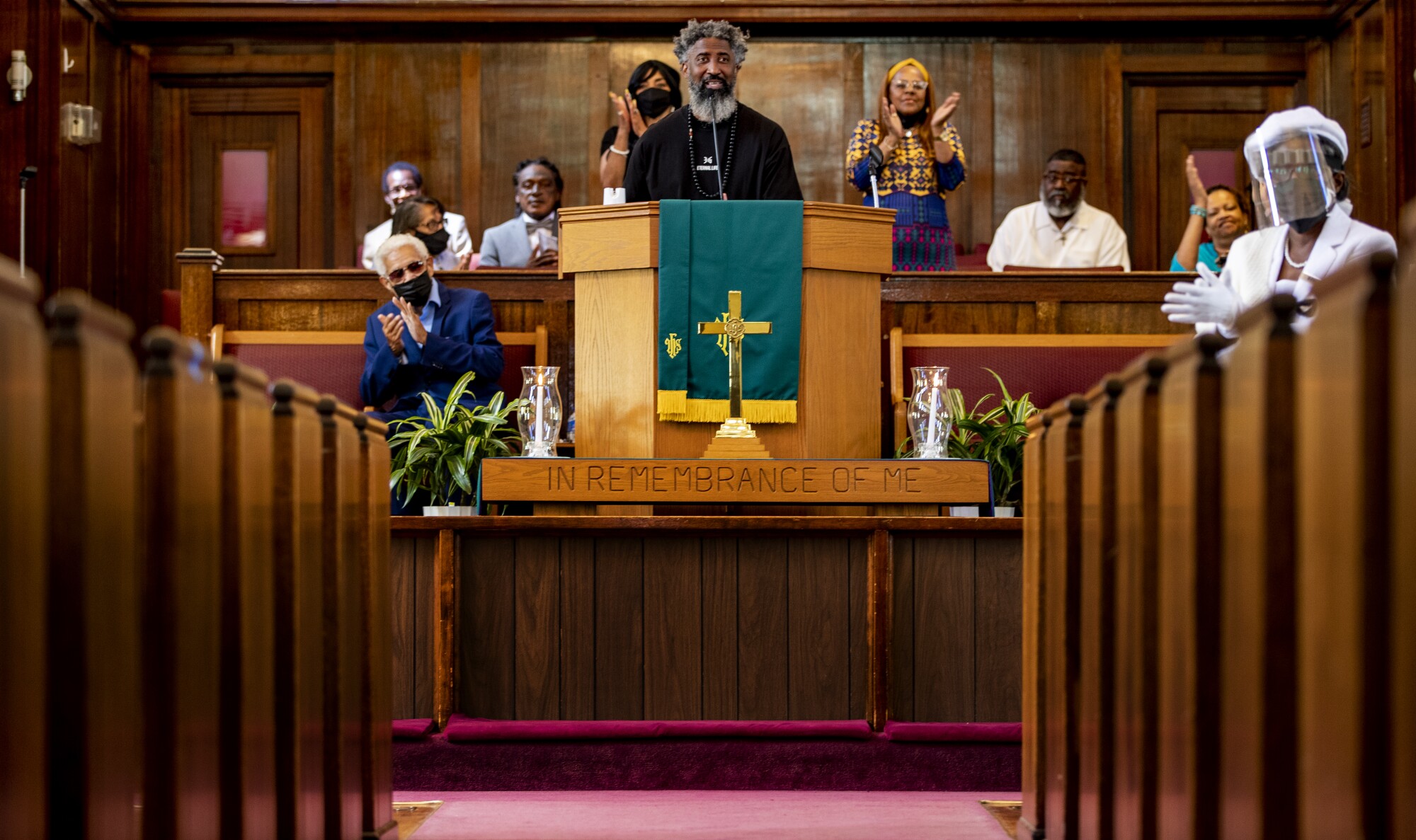
“Every time your child leaves home, they are in danger of dying,” Pastor Barry Settle said in a recent sermon at Allen Chapel AME Church in Riverside, pointing to recent racist massacres while celebrating Juneteenth.
(Gina Ferazzi / Los Angeles Times)
During my exploration of the area, I drive through grassy hillsides bursting with yellow flowers along Highway 71 in Chino Hills. All of a sudden, I’m treated to a spectacular sight: the intricately carved pink stone domes and towers of the Shri Swaminarayan Mandir, a 20-acre Hindu temple complex, bubbling up above the surrounding warehouses. It makes this born-and-raised Baptist marvel at the sheer audacity of those who built it right by the side of the road, where everyone can be awed by it.
Black churches like Allen Chapel — an African Methodist Episcopal church in Riverside that’s tucked away on a side street lined with Craftsman and Victorian bungalows decked with flowers — have served to anchor residents in a less flashy but equally vital way.
Soon after moving here, Fatima heard about Allen Chapel Pastor Barry Settle’s way of weaving current issues into his sermons. She joined the congregation, but the pandemic often forced her to watch its services from home on a livestream.
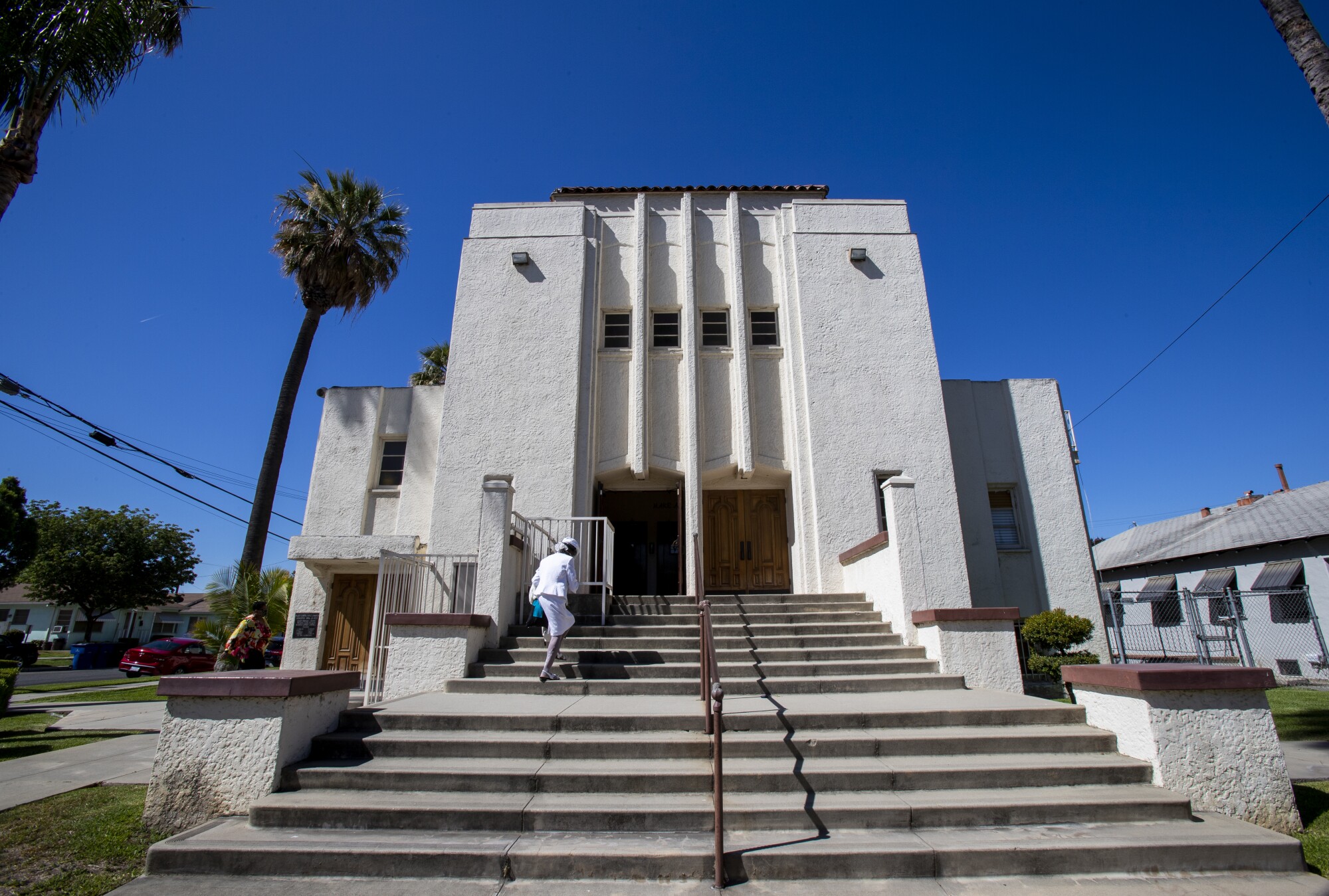
Allen Chapel African Methodist Episcopal Church in Riverside has become one anchor for Black residents who’ve relocated to the Inland Empire.
(Gina Ferazzi / Los Angeles Times)
On Juneteenth, which fell on a Sunday this year, Settle’s voice crescendos and dives, and worshipers raise their hands to the ceiling, as he commemorates the end of slavery in the U.S. This is also a day of remembrance for traumas inflicted in our own time.
I shake my head in shame for this country as Settle honors the nine Black worshipers at Mother Emanuel AME Church in Charleston, S.C., who were shot dead by a white supremacist in 2015, and the victims of two gun massacres in May: the racially motivated killing of 10 Black Americans at a supermarket in Buffalo, N.Y., and the murder of 19 schoolchildren and two teachers in Uvalde, Texas, a predominantly Latino town.
“Our children can’t go to school. Our children can’t go to church. Our children can’t go to the grocery store,” Settle tells the congregation, his voice rising in anger. “Every time your child leaves home, they are in danger of dying.”
Settle, 55, an L.A. native, says it can be a challenge to reassure and inspire his flock given that the nation’s turmoil at times feels like it’s closing in on them.
“Peace doesn’t mean the absence of problems,” he says. “It’s security, even in the midst of the problems we face in society.”
As I bow my head in prayer at Allen Chapel and listen to worshipers moan to release their worries, I feel so proud of my people’s determination to do more than merely keep on keeping on.
On a 101-degree afternoon, the Nelsons and I sit under a shade tree in their front yard and watch the youngest child, Tariq, playfully move from one relative’s lap to another.
Despite my reservations, I have to accept that the Inland Empire has given this family a kind of freedom that many of us wish for and never find.
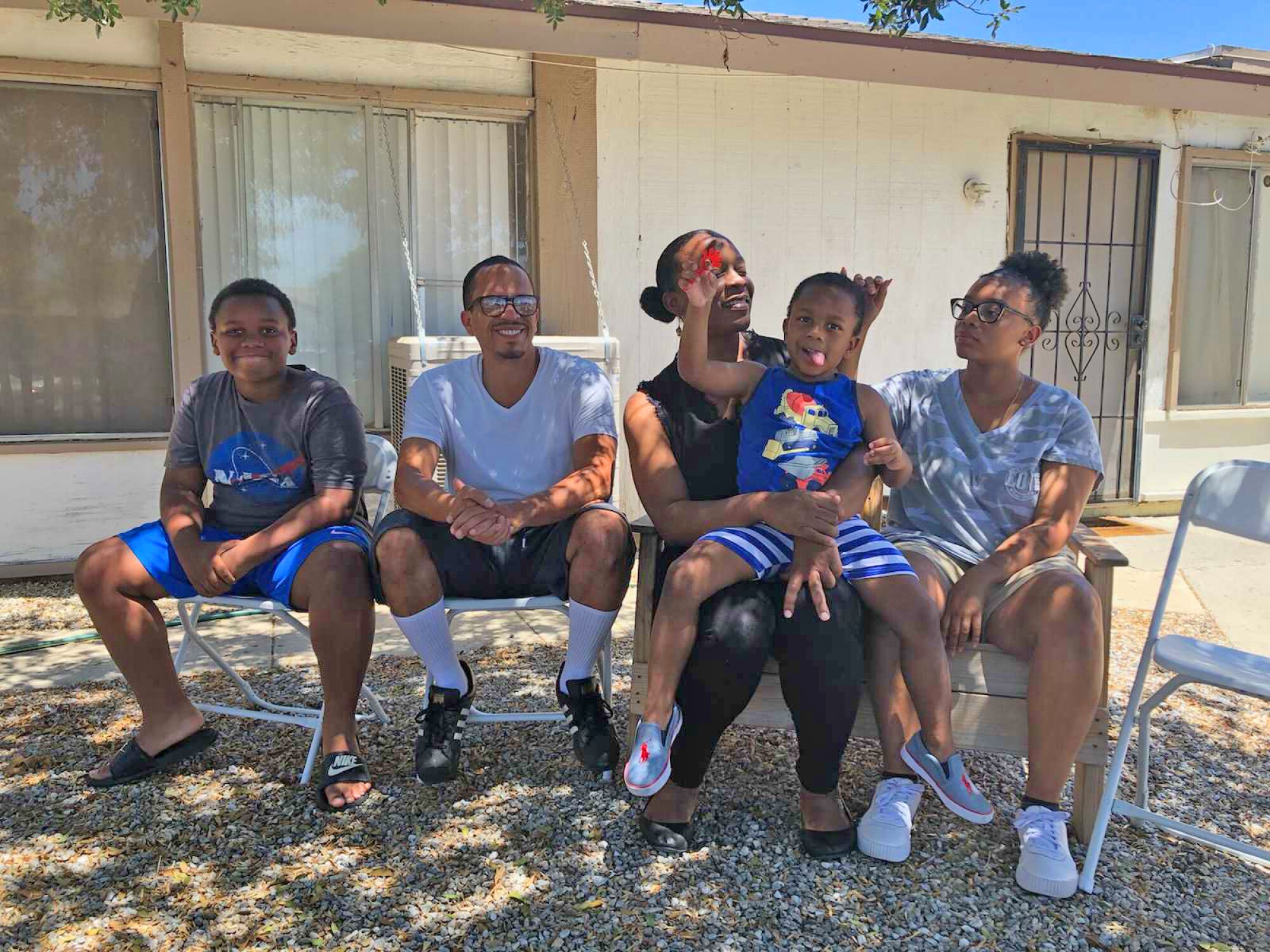
“My husband and I decided that we will traumatize them no more,” Fatima Nelson says of pulling their eldest children from Long Beach schools that had few Black students. Here, she and husband Arthur Nelson II relax outside their Moreno Valley home with Arthur III, Tariq and Julia, from left.
(Tyrone Beason / Los Angeles Times)
Sometimes Fatima will awaken at dawn, walk outside to the back patio and “just watch the sun rise.”
Grinning and unfazed by the heat, Fatima says she constantly reminds her children to appreciate where they now live — to treasure the open skies and the serenity that their father raves about, a quiet so profound that on this afternoon, we can hear birds singing in the distance.
Fatima turns to Julia.
“What do I say all the time?” she asks her daughter. “Let the breeze wash over your skin.”
So we listen as a gust rustles the leaves, and let a calm, that feels as if it’s been gathering for longer than any of us can measure, wash over all of us.

